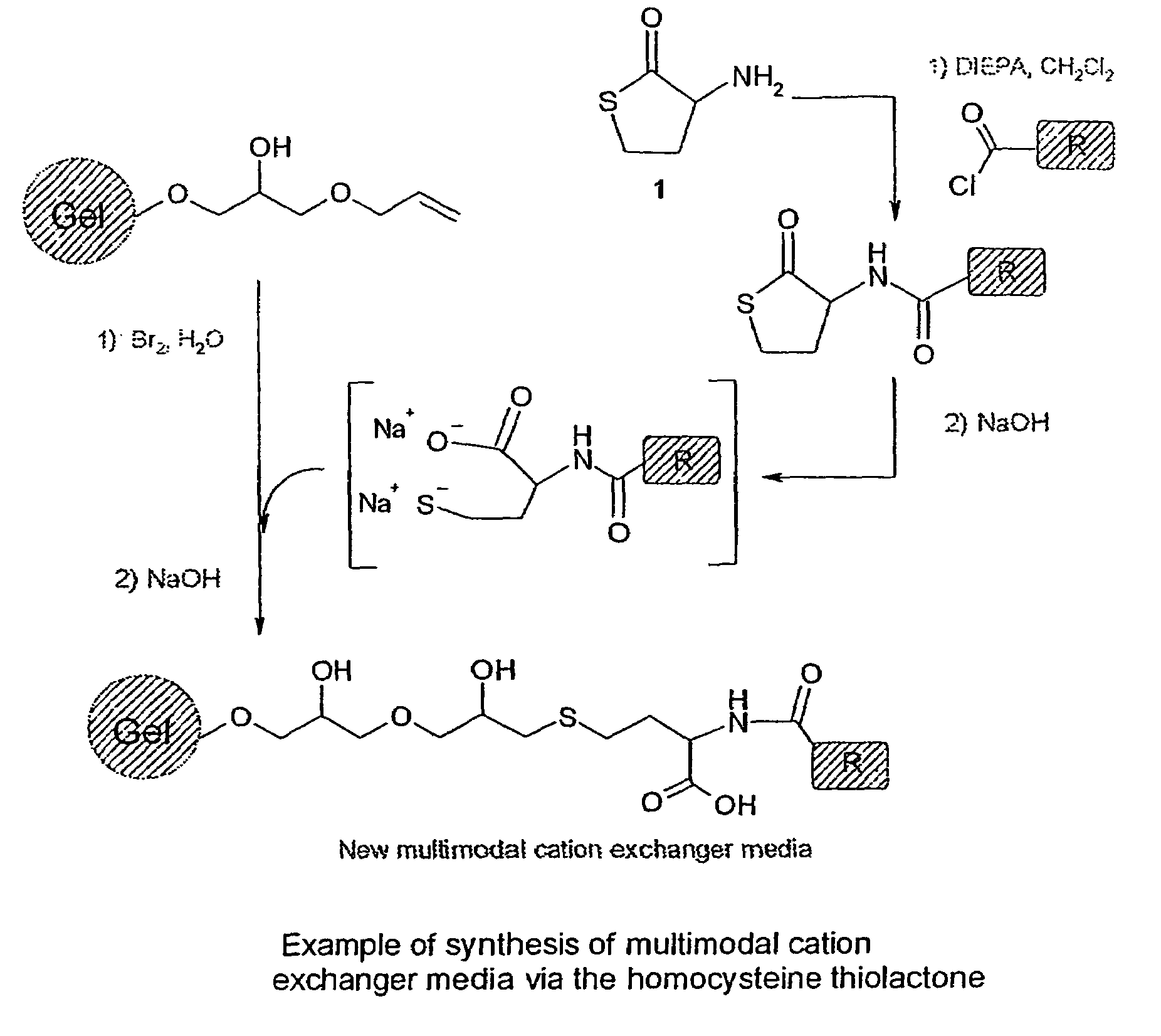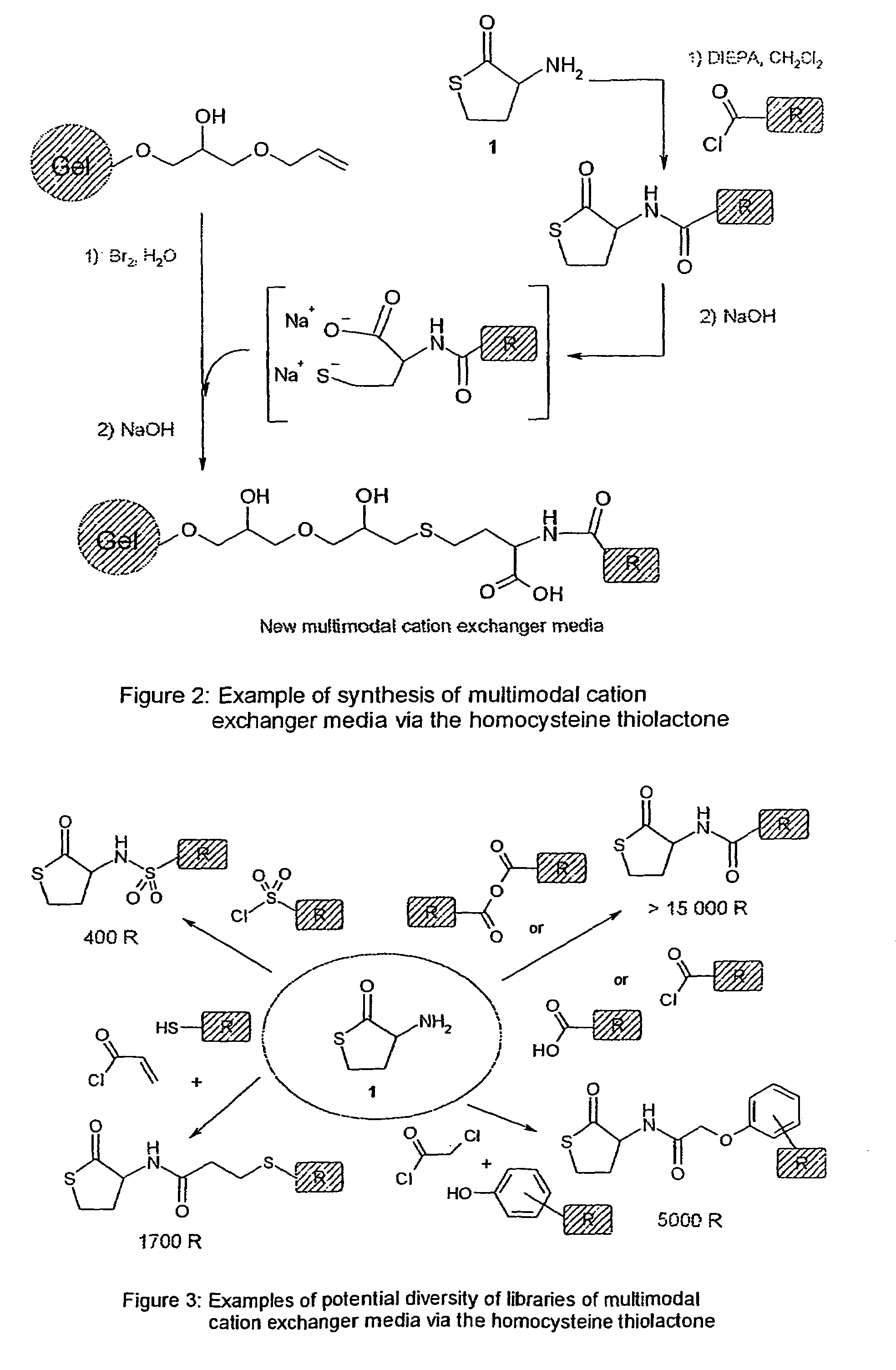Generation of ion exchanger media
a technology of ion exchanger and media, applied in the field of separation, can solve the problems of less robust methods of preparation and use, less advantageous in practice, and failure to convert, and achieve the effect of easy control
- Summary
- Abstract
- Description
- Claims
- Application Information
AI Technical Summary
Benefits of technology
Problems solved by technology
Method used
Image
Examples
examples
Generation of Separation Media According to the Invention Using Different R-Z-Groups
examples 1 – 4
Examples 1–4
[0117]The following examples were using D,L homocysteine thiolactone Ia as a scaffold and the described chemistry (cf. Scheme 1 above). After formation of the amide or the sulphonamide bound by reacting homocysteine thiolactone Ia with acyl chlorides, sulfonyl chlorides, anhydrides or activated acid, the opening of the thiolactone ring was realised with basic hydrolysis and the resulting compound further coupled to an activated Sepharose® 6FF or Sepharose® 4FF (both from Amersham Biosciences AB, Uppsala, Sweden).
[0118]All the solutions A were freshly prepared but it is possible to reuse the solution mixture issued from the filtration after the coupling reaction (in Step 3) and to further react it with another gel. In the following examples the filtrate from the first reaction (gel with an allyl loading of 411 μmol / mL) was further used with a gel with an allyl loading of 250 μmol / mL according to Step 1a, 2 and 3. In Table 1A the results from the gel with an allyl loading ...
example 1
Acyl Chlorides
[0120]1a. The solution B was prepared with 2.37 g (10.3 mmol) of 3,4,5-trimethoxy-benzoyl chloride in 4 mL DCM and according to Step 1a, added to solution A. Following Step 2 the solvent was removed and 6 mL of a solution of sodium hydroxide 5N was added to the crude material. According to Step 3, 5 mL of brominated Sepharose® 6FF (Amersham Biosciences AB, Uppsala, Sweden) with an allyl loading of 411 μmol / mL of gel was added to the mixture. The ionic capacity of the gel 1a was 232.6 μmol / nL.
[0121]1b. The solution B was prepared with 1.80 g (10.3 mmol) of 4-chlorobenzoyl chloride in 4 mL DCM and according Step 1a, added to solution A. Following Step 2 the solvent was removed and 6 mL of a solution of sodium hydroxide 5N was added to the crude material. According to Step 3, 5 mL of brominated Sepharose® 6FF with an allyl loading of 411 μmol / mL of gel was added to the mixture. The ionic capacity of the gel 1b was 251.1 μmol / mL.
[0122]1c. The solution B was prepared with 2...
PUM
| Property | Measurement | Unit |
|---|---|---|
| Molar density | aaaaa | aaaaa |
| Molar density | aaaaa | aaaaa |
| Molar density | aaaaa | aaaaa |
Abstract
Description
Claims
Application Information
 Login to View More
Login to View More - R&D
- Intellectual Property
- Life Sciences
- Materials
- Tech Scout
- Unparalleled Data Quality
- Higher Quality Content
- 60% Fewer Hallucinations
Browse by: Latest US Patents, China's latest patents, Technical Efficacy Thesaurus, Application Domain, Technology Topic, Popular Technical Reports.
© 2025 PatSnap. All rights reserved.Legal|Privacy policy|Modern Slavery Act Transparency Statement|Sitemap|About US| Contact US: help@patsnap.com



